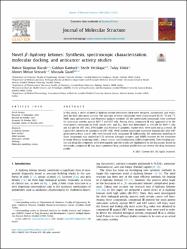| dc.contributor.author | Başpınar Küçük, Hatice | |
| dc.contributor.author | Kantürk, Gökhan | |
| dc.contributor.author | Yerlikaya, Şerife | |
| dc.contributor.author | Yıldız, Tülay | |
| dc.contributor.author | Şentürk, Ahmet Mesut | |
| dc.contributor.author | Güzel, Mustafa | |
| dc.date.accessioned | 2021-11-05T06:00:06Z | |
| dc.date.available | 2021-11-05T06:00:06Z | |
| dc.date.issued | 2022 | en_US |
| dc.identifier.citation | Başpınar Küçük, H., Kantürk, G., Yerlikaya, Ş., Yıldız, T., Şentürk, A. M. ve Güzel, M. (2022). Novel β‑hydroxy ketones: Synthesis, spectroscopic characterization, molecular docking, and anticancer activity studies. Journal of Molecular Structure, 1250. https://dx.doi.org/10.1016/j.molstruc.2021.131772 | en_US |
| dc.identifier.issn | 0022-2860 | |
| dc.identifier.uri | https://dx.doi.org/10.1016/j.molstruc.2021.131772 | |
| dc.identifier.uri | https://hdl.handle.net/20.500.12511/8564 | |
| dc.description.abstract | In this study, a series of novel β‑hydroxy ketone derivatives 3a-o were designed, synthesized, and evaluated for their anticancer activity. The structure of these compounds were characterized by IR, 1H and 13C NMR, mass spectrometry and elemental analysis methods. All the synthesized compounds were screened for anticancer activity against MCF-7 and U87 cells. Among them, compound 3l was appeared to be the most potent compound on both cancer cells; and IC50 dose was determined as 145 µM for MCF-7 cells and 6,6 µM for U87 cells. DNA ladder and Annexin V apoptotic marker tests were used and as a result, 3l caused the initiation of apoptosis on U87 cells. VDAC protein expression increased dramatically after U87 glioblastoma brain cancer cells were treated with compound 3l Additionally, the molecular modeling of these compounds was studied in FLT3 receptor, Estrogen receptor, and PARP2 receptor for the treatment of Acute Myeloid Leukemia (AML), breast cancer, and Glioblastoma (GBM) respectively. Their binding motifs and drug-like properties were investigated, and the results are highlighted in the discussion. Based on the results, compound 3l may have a potential drug candidate profile that can reverse the drug resistance profile. | en_US |
| dc.language.iso | eng | en_US |
| dc.publisher | Elsevier B. V. | en_US |
| dc.rights | info:eu-repo/semantics/embargoedAccess | en_US |
| dc.subject | Aldol Reaction | en_US |
| dc.subject | Anticancer Activity | en_US |
| dc.subject | Docking | en_US |
| dc.subject | Keto Alcohol | en_US |
| dc.subject | Molecular Modeling Studies | en_US |
| dc.subject | Β-Hydroxy Ketones | en_US |
| dc.title | Novel β‑hydroxy ketones: Synthesis, spectroscopic characterization, molecular docking, and anticancer activity studies | en_US |
| dc.title.alternative | Novel beta-hydroxy ketones: Synthesis, spectroscopic characterization, molecular docking, and anticancer activity studies | en_US |
| dc.type | article | en_US |
| dc.relation.ispartof | Journal of Molecular Structure | en_US |
| dc.department | İstanbul Medipol Üniversitesi, Sağlık Hizmetleri Meslek Yüksekokulu, Tıbbi Laboratuvar Teknikleri Ana Bilim Dalı | en_US |
| dc.department | İstanbul Medipol Üniversitesi, Rektörlük, Rejeneratif ve Restoratif Tıp Araştırmaları Merkezi (REMER) | en_US |
| dc.department | İstanbul Medipol Üniversitesi, Rektörlük, Sağlık Bilim ve Teknolojileri Araştırma Enstitüsü | en_US |
| dc.department | İstanbul Medipol Üniversitesi, Uluslararası Tıp Fakültesi, Dahili Tıp Bilimleri Bölümü, Tıbbi Farmakoloji Ana Bilim Dalı | en_US |
| dc.authorid | 0000-0002-1423-0435 | en_US |
| dc.identifier.volume | 1250 | en_US |
| dc.relation.publicationcategory | Makale - Uluslararası Hakemli Dergi - Kurum Öğretim Elemanı | en_US |
| dc.identifier.doi | 10.1016/j.molstruc.2021.131772 | en_US |
| dc.identifier.wosquality | Q3 | en_US |
| dc.identifier.wos | 000718046000013 | en_US |
| dc.identifier.scopus | 2-s2.0-85118193306 | en_US |
| dc.identifier.scopusquality | Q2 | en_US |


















